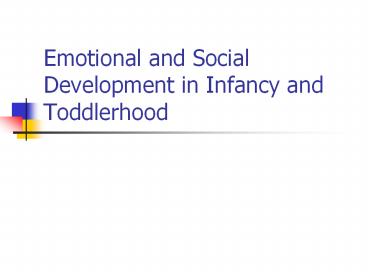Emotional and Social Development in Infancy and Toddlerhood - PowerPoint PPT Presentation
1 / 23
Title:
Emotional and Social Development in Infancy and Toddlerhood
Description:
Emotional and Social Development in Infancy and Toddlerhood Erikson s Theories of Personality Development Inner Conflicts that consist of polar opposites Trust vs ... – PowerPoint PPT presentation
Number of Views:664
Avg rating:3.0/5.0
Title: Emotional and Social Development in Infancy and Toddlerhood
1
Emotional and Social Development in Infancy and
Toddlerhood
2
Eriksons Theories of Personality Development
- Inner Conflicts that consist of polar opposites
- Trust vs Mistrust Frueds Oral Stage
- Autonomy vs Shame and Doubt Anal
- How do we build autonomy in Infants?
3
Emotional Development
- Do infants come into the world showing signs of
basic emotions?
4
3 basic emotions have received the most attention.
- Happiness-first in smiles, later in laughter
- Infants smile within a few days of birth- while
asleep, in response to touches, etc. Around 6-10
weeks first social smiles occur. Laughter 3-4
months. - Anger and Fear- distress to unpleasant
experiences. - Hunger, pain, stress, medical procedures, too
much or too little stimulation, changes in body
temperature
5
Temperament
- What is it?
- Types
- 3 basic
- Easy child
- Difficult child
- Slow to warm up child
- Other
- What type are you. Split up into groups and list
characteristics of these people.
6
Temperament
- What is it?
- Types
- 3 basic
- Easy child
- establishes routines, cheerful, adapts easily
- Difficult child
- irregular daily routines, slow to accept new
experiences, reacts negatively, cries often - Slow to warm up child
- inactive, low-key reactions, negative in mood,
adjusts slowly to new situations, clingy
7
Other temperaments
- Active- wiggles, moves constantly
- Bold- takes initiative
- Fearful-easily afraid
- Shy-quieter, less vocal
- Timid-wary of strangers, shows caution in play.
8
Temperament
- Goodness-of-fit- how temperament and environment
work together to produce favorable outcomes. - Children with different temperaments have
different child-rearing needs.
9
Attachment
- Develops in 4 phases
- Preattachment- birth -6 weeks
- Grasping, smiling, crying and gazing help secure
relationships with an adult. Recognize parents
smell and voice. Generally dont mind being left
with others. - Attachment in the making- 6weeks to 8 months
- React differently to caregivers than strangers
10
Attachment
- Clearcut attachment- 8 months to 2 years-
- Separations anxiety- becomes upset when adult
they are used to leaves. - Older infants and toddlers try to stay in their
presence. Caregiver becomes secure base from
which to explore. - Formation of reciprocal relationships- 2 years on
- Separation protest declines. Tie themselves to
caregiver as a substitute to parent.
11
Types of attachment
- Secure- use parents as secure base for
exploration/65 of babies - Avoidant- unresponsive when parent is present,
slow to greet parent and then dont cling. 20 of
babies - Resistant-seek closeness to parent and fail to
explore, display anger when returns 10-15 of
babies - Disorganized-disoriented- greatest
insecurity-show contradictory behaviors
12
Attachment
- What would an infant/toddler look like at each
stage?
13
Anxiety
- Stranger
- Separation
14
Self-awareness
- Infants exposed to a mirror at a young age do not
know the image is different from themselves. - Self-awareness leads to empathy- awareness of
others feelings - Also leads to self-control-resisting impulses
15
Applications
- Respond quickly with warmth to infants cry
- Plan to spend time at the child care center
before the infant begins - Create a playspace that allows for choice,
independence and exploration - Model positive emotions
- Facilitate peer interaction
- Model prosocial behaviors
- Demonstrate play skills
16
Social Emotional Development
- Preschoolers
17
Erikson
- Initiative vs guilt
18
Social Competence
- Sociometric Status
- Popular children
- Rejected children
- Neglected children
19
Popular
- Socially active
- Highly directive
- Linguistically effective
- Positive in affect
- Diplomatic
- Skilled in conflict resolution
- Skilled in play group entry
- Competent in interpreting social situations
20
Rejected
- Negative
- Whiny
- Unpredictably aggressive
- Unskilled at interpreting social situations
- Antisocial and isolated from peers
21
Neglected
- Isolated from peers
- Shy
- Unskilled at entering play groups
- Unskilled in capturing peer attention
- Unskilled in play leadership
22
Partens Play behavior
- Unoccupied play behavior
- Little interest in toys, persons, and activities
- Onlooker behavior
- Shows interest in peers, but engages in no social
contact - Parallel Play
- Engages in activities side by side with peers but
rarely converses or interacts - Associative Play
- Pursues individual play themes but interacts
often - Cooperative Play
- Adopts a single, coordinated play theme with
peers.
23
Aggression
- Verbal aggression
- Teasing name calling, verbal taunts
- Physical aggression
- Hitting, pushing, biting
- Reactive
- Aggression provoked by peers
- Proactive
- Aggression not provoked, unexpected
- Instrumental
- Proactive aggression that has a clear goal.
- Bullying
- Proactive aggression that has no clear goal and
is often hostile in intent































